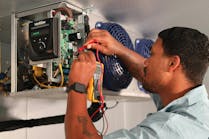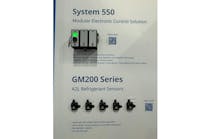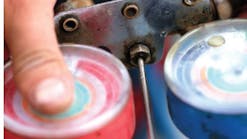In today's ever-evolving supermarket landscape, advancements in refrigeration technology and energy efficiency have led to more sophisticated and environmentally friendly systems. However, while the control capabilities of these modern systems have become more complex, the core principles of refrigeration remain unchanged. Effective diagnostics still hinge on a deep understanding of fundamental refrigeration theory and physics. Even as technicians gain access to precision tools and vast libraries of resources, the art of logical analysis and methodical troubleshooting remains as critical as ever.
Modern supermarkets are constantly evolving, with advancements in greener technologies and energy efficiency being made daily. These innovations bring enhanced control capabilities but also add complexity to refrigeration systems. However, it's important to remember that, despite this added complexity, the fundamentals of refrigeration remain unchanged. Diagnosing these advanced systems still relies on a solid understanding of basic refrigeration theory and physics.
A technician's arsenal of tools hasn't fundamentally changed over the years. What has evolved is the precision and accuracy these tools now provide, making diagnostics faster and more reliable. Additionally, many modern tools and apps give technicians access to vast libraries of refrigeration formulas and theoretical resources, greatly assisting in diagnosing issues with a higher level of accuracy.
Despite advancements in tools and technology, each situation still requires a case-by-case assessment. Effective diagnosis relies heavily on deductive reasoning and logical analysis. Technicians must make educated assumptions about where to start their investigation — whether the issue lies within a specific case or if it's a broader system malfunction. This approach is similar to the Socratic method, where thoughtful questioning and analysis guide the problem-solving process.
Each technician has their own procedure for diagnosing issues, but when I start, I start at the mechanical room. This is where I will be able to locate the energy management controller, where you should be able to monitor the pressures, temperatures and other alarms that might have led to the alarm.
Remember these systems have detailed refrigeration schedules, and installation operation manuals that will tell you where the pressures temperature, and amperages should be running around the stem will be normally
Each technician may have their own preferred procedure for diagnosing issues, but my approach always begins in the mechanical room. This area houses the energy management controller, where I can monitor critical data such as pressures, temperatures, and alarms leading up to the fault. It's essential to utilize the detailed refrigeration schedules and installation operation manuals that these systems provide. These resources specify the expected pressures, temperatures, and amperages, helping you understand where the system should normally be running. The other nice thing about checking the history in the controls systems, typically you can deduce issues and correlate some issues where you can see some cause and effect… Example : if you see the temperature drop throughout the night thus holding more liquid in the condenser , seeing the receiver level drop then seeing the cases running higher temp because of lack of liquid going to cases. Where in the past we did not have controls to monitor all these temps, pressures, and levels unless you were there you would have no idea why the temperatures started to increase in the refrigerated case.
As an experienced technician I can utilize trends in the graphs to come up with a logical cause and effect within conjunction with using standard refrigeration theory
Once I know everything is in order with the mechanical room checking pressures, temperatures, and checking for proper liquid level, and temperature. I know, the issue is probably an issue with the case line up.
I utilize ABC method when looking at a case line up, I can get all the data needed from the installation and operation manual needed for this method from the manufacture
Here is The ABC’s of HVAC-R -- Air Before Charge
Whether it's (CFM) — Cubic Feet Per Minute — check your air flow first. The reason for this is because too much air or too little air will make the next thing that we look at too low or too high, which is the SST or Suction Saturated Temperature. This is done by taking a pressure sample at the outlet of the evaporator and knowing what refrigerant we are utilizing, thus being able to convert that pressure into a temperature.
This SST needs to be at spec or within 3 degrees lower than what the spec is called for, example if the case spec is 20°F we can be at 20-17°F SST any lower than that we really start not affect the sizing of our coil and Expansion device.
The last measurement that we should check is superheat, this is only after verifying the other 2 measurements that we have just done. This is done by checking the SST and then Subtracting the Suction line temp near where your TXV bulb placement is, Example if the SST was 20°F and the suction line temperature was 28°F the Superheat is 8°F. most spec for medium temp cases is 6-8°F of superheat.
If a refrigeration case meets all manufacturer specifications, it should initially be capable of achieving and maintaining the desired temperatures without issue. However, there can be other contributing factors, such as ambient conditions, that impact case performance. It’s important to remember that case defrost specifications are based on optimal operating conditions. For instance, if the ambient temperature rises above 75°F or the relative humidity exceeds 55%, cases may frost over before the next scheduled defrost cycle.
Modern refrigeration systems have become increasingly complex with the integration of electronic controllers. These controllers manage critical parameters such as Suction Saturated Temperature (SST), superheat, discharge air temperature, defrost duration, defrost termination, and even fan speed—all of which are now regulated digitally. As a result, technicians must not only measure these variables but also ensure the sensors providing this data are accurate. This additional layer of complexity requires a meticulous approach to verify both the performance of the equipment and the accuracy of the monitoring devices.
Follow a Balanced Approach
Diagnosing and maintaining advanced supermarket refrigeration systems requires a balanced approach that combines foundational refrigeration knowledge with the ability to navigate sophisticated control technologies. By understanding the fundamentals and applying logical reasoning, technicians can effectively troubleshoot issues and ensure optimal system performance, even in the face of evolving technological advancements.
Brett Wetzel is an established commercial refrigeration authority. He is the Director of Strategic Technical Services and Solutions for Future Green Now (fgn-global.com) and host of the Advanced Refrigeration Podcast. He will be conducting a podcast at Sporlan's booth #1943 during AHR Expo 2025.










